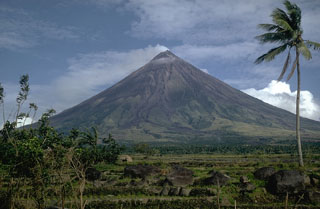Report on Mayon (Philippines) — 19 July-25 July 2006
Smithsonian Institution / US Geological Survey
Weekly Volcanic Activity Report, 19 July-25 July 2006
Managing Editor: Sally Sennert.
Please cite this report as:
Global Volcanism Program, 2006. Report on Mayon (Philippines) (Sennert, S, ed.). Weekly Volcanic Activity Report, 19 July-25 July 2006. Smithsonian Institution and US Geological Survey.
Mayon
Philippines
13.257°N, 123.685°E; summit elev. 2462 m
All times are local (unless otherwise noted)
PHIVOLCS reported that during 19-24 July lava flows from Mayon traveled SSE a maximum distance of 4 km from the summit toward the Bonga gully and branched off to the W and E. Incandescent blocks shed from the toe and margins of the flows were visible at night and traveled SE. Ash plumes generated from the rolling blocks produced light ash fall 8.5 km E of the summit in Sta. Misericordia. On 20 July, pyroclastic flows were observed on the SE slopes prompting ~100 families to evacuate. On 22 July, lava flows advanced SE towards the Mabinit channel. The lava flows were within the 6 km radius Permanent Danger Zone.
Geological Summary. Symmetrical Mayon, which rises above the Albay Gulf NW of Legazpi City, is the most active volcano of the Philippines. The steep upper slopes are capped by a small summit crater. Recorded eruptions since 1616 CE range from Strombolian to basaltic Plinian, with cyclical activity beginning with basaltic eruptions, followed by longer periods of andesitic lava flows. Eruptions occur predominately from the central conduit and have also produced lava flows that travel far down the flanks. Pyroclastic density currents and mudflows have commonly swept down many of the approximately 40 ravines that radiate from the summit and have often damaged populated lowland areas. A violent eruption in 1814 killed more than 1,200 people and devastated several towns.
Sources: Gulf News, Philippine Institute of Volcanology and Seismology (PHIVOLCS), Agence France-Presse (AFP)

